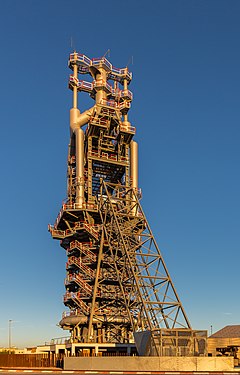Term: Blast furnace
**Historical Evolution of Blast Furnaces**:
– Blast furnaces have a long history, dating back to ancient China and spreading to Europe during the Middle Ages.
– Innovations like the use of coke in blast furnaces in 1709 and the patenting of preheating combustion air in 1828 have significantly improved the process.
– Advancements like hot blast technology and the spread of blast furnace technology to different regions have shaped its evolution over centuries.
**Environmental Impact and Decarbonization Efforts**:
– Blast furnaces have contributed significantly to global greenhouse gas emissions.
– Initiatives like injecting hydrogen into blast furnaces and programs like ULCOS aim to reduce carbon emissions by significant percentages.
– Ongoing research focuses on incorporating technologies like CCS, hydrogen, and biomass to decarbonize iron and steel production processes.
**Technological Advancements and Future Prospects**:
– Continuous research is ongoing to develop more sustainable practices in blast furnace operations.
– Technologies like Top-Gas Recycling Blast Furnace and new process routes are being explored to reduce specific emissions significantly.
– Incorporation of CCS, hydrogen, and electricity shows promise in decarbonizing iron and steel production processes.
**Operational Aspects of Blast Furnaces**:
– Blast furnaces convert iron oxides to elemental iron through chemical reduction using carbon monoxide.
– Key factors like particle size and quality of coke or charcoal are crucial for maintaining permeability in the furnace.
– Blast furnaces operate continuously and remove silica from pig iron by reacting with calcium oxide to form slag.
**Industrial Applications and Structural Components**:
– Blast furnaces play a crucial role in modern iron production and the steelmaking industry.
– Structural components like refractory linings, uptakes for gas exit, and dust collectors are essential for efficient blast furnace operation.
– Raw material charging methods, casthouse features, and exhaust treatment systems are integral parts of blast furnace operations.
A blast furnace is a type of metallurgical furnace used for smelting to produce industrial metals, generally pig iron, but also others such as lead or copper. Blast refers to the combustion air being supplied above atmospheric pressure.

In a blast furnace, fuel (coke), ores, and flux (limestone) are continuously supplied through the top of the furnace, while a hot blast of air (sometimes with oxygen enrichment) is blown into the lower section of the furnace through a series of pipes called tuyeres, so that the chemical reactions take place throughout the furnace as the material falls downward. The end products are usually molten metal and slag phases tapped from the bottom, and waste gases (flue gas) exiting from the top of the furnace. The downward flow of the ore along with the flux in contact with an upflow of hot, carbon monoxide-rich combustion gases is a countercurrent exchange and chemical reaction process.
In contrast, air furnaces (such as reverberatory furnaces) are naturally aspirated, usually by the convection of hot gases in a chimney flue. According to this broad definition, bloomeries for iron, blowing houses for tin, and smelt mills for lead would be classified as blast furnaces. However, the term has usually been limited to those used for smelting iron ore to produce pig iron, an intermediate material used in the production of commercial iron and steel, and the shaft furnaces used in combination with sinter plants in base metals smelting.
Blast furnaces are estimated to have been responsible for over 4% of global greenhouse gas emissions between 1900 and 2015, but are difficult to decarbonize.
